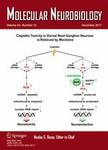版权所有:内蒙古大学图书馆 技术提供:维普资讯• 智图
内蒙古自治区呼和浩特市赛罕区大学西街235号 邮编: 010021

作者机构:Fujian Med Univ Dept Neurosurg Fuzong Clin Med Coll Fuzhou 350025 Peoples R China Xiamen Univ Dongfang Affiliated Hosp Sch Med Dept Neurosurg Xiamen 361005 Peoples R China Fujian Med Univ Fujian Canc Hosp Dept Mol Pathol Clin Oncol Sch Fuzhou 350014 Peoples R China Fujian Med Univ Hosp 900 Dept Anesthesiol & Perioperat Med Fuzong Clin Med Coll Fuzhou 350025 Peoples R China Fujian Univ Tradit Chinese Med Fuzhou 350122 Peoples R China Fujian Med Univ Hosp 900 Dept Neurosurg Fuzong Clin Med Coll Fuzhou 350025 Peoples R China Fujian Med Univ Lab Basic Med Fuzong Clin Med Coll Fuzhou 350025 Peoples R China Fujian Med Univ Hosp 900 Lab Basic Med Fuzong Clin Med Coll Fuzhou 350025 Peoples R China
出 版 物:《MOLECULAR NEUROBIOLOGY》 (Mol. Neurobiol.)
年 卷 期:2024年第61卷第8期
页 面:6060-6076页
核心收录:
学科分类:1002[医学-临床医学] 1001[医学-基础医学(可授医学、理学学位)] 10[医学]
基 金:Fujian Provincial Finance Department
主 题:SIRT1 HMGB1 Deacetylation Neutrophil extracellular trap Cerebral venous thrombosis
摘 要:Cerebral venous thrombosis (CVT) is a neurovascular disease with recently increasing incidence. Aseptic inflammatory responses play an important role in the pathology of CVT. Recent studies report that neutrophil extracellular traps (NETs) are major triggers of thrombosis and inflammation in stroke, but their effect on brain injury in CVT requires further validation. In this study, two CVT animal models were used to simulate superior sagittal sinus thrombosis and cortical vein thrombosis. The effects of brain tissue infiltration of NETs and the molecular mechanisms associated with NET formation were deeply explored in combination with proteomics, histology, and serology. The results showed that the cortical vein thrombosis model could be combined with more severe blood-brain barrier (BBB) disruption and showed more severe cerebral hemorrhage. Decreased Sirtuin 1 (SIRT1) expression promotes high mobility group box 1 (HMGB1) acetylation, causing increased cytosolic translocation and extracellular release, and HMGB1 can promote NET formation and recruitment. In addition, corticocerebral accumulation of NETs contributes to BBB damage. This establishes a vicious cycle between BBB damage and NET accumulation. SIRT1 mediated-HMGB1 deacetylation may play a critical role in attenuating BBB damage following CVT. This study employed a combined validation using models of venous sinus thrombosis and cortical vein thrombosis to investigate the deacetylation role of SIRT1, aiming to offer new insights into the pathological mechanisms of brain injury following CVT.